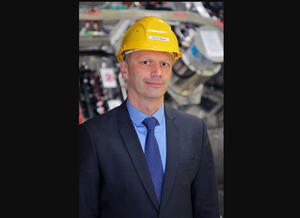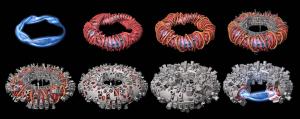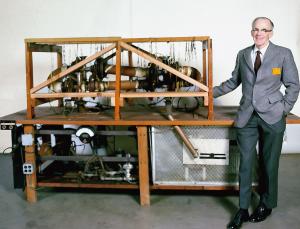Stellarators "an option" for future power plants
In the history of magnetic fusion, the photo is iconic. A smiling, bespectacled middle-aged man stands next to a strange contraption sitting on a makeshift wooden table. The man is Princeton astrophysicist Lyman Spitzer; the contraption is the first attempt at building a fusion machine, the Figure 8-Model A stellarator. Stellarators have come a long way since Spitzer's machine was built in 1952. After falling victim to the success of tokamaks in the late 1960s, these peculiar and contorted machines were the focus of renewed attention three decades ago thanks, mostly, to progress achieved in computer-assisted design. Today, realizing the promise of the stellarator design rests on a handful of machines, foremost among them Wendelstein 7-X, operated in Greifswald, Germany, by the Max Planck Institute for Plasma Physics. In the interview below, Thomas Klinger, the scientific director of the Wendelstein 7-X project, tells us about the project's progress, challenges and perspectives.
When asked in a 2011 Newsline interview how stellarators differed from tokamaks, you said, "In a stellarator, confining the plasma is like holding a broomstick firmly in your fist; in a tokamak, it's like trying to balance the same broomstick on your finger." Ten years later, how well is Wendelstein 7-X holding the broomstick?
Very well indeed. Our experience with Wendelstein 7-X during its first two operation phases was entirely positive, especially with regard to stability and controllability. After appropriate conditioning of the first wall with glow discharges and a thin layer of boron carbide, we have obtained high plasma densities and good plasma temperatures, taking into account that the plasma heating power was not yet available at the foreseen levels. One of the highlights was the demonstration of full function of the so-called island divertor of Wendelstein 7-X, which paved the way for constant and stable high density plasmas running for 30 seconds without interruption. With additional plasma fuelling with ice pellets, we have even achieved a stellarator record value of the triple product, though only transiently yet. These were remarkable results. We also learned that plasma turbulence plays the major role, like in tokamaks, since the neoclassical transport in Wendelstein 7-X could be reduced to a minimum thanks to the optimized magnetic field. So it is not all "blue sky": the plasma turbulence sets a limit to the maximum achievable ion temperature.
What are the next steps in the Wendelstein 7-X scientific program?
During the previous operation phases it turned out that, due to plasma turbulence, it is not a straightforward path to obtaining high ion temperatures by heating the electrons with strong microwaves, which is the main heating scheme on Wendelstein 7-X. In the already-mentioned record plasmas, turbulence was significantly reduced by making the radial density profile much steeper—e.g., by ice pellet injection—and consequently the ion temperature went up a lot. This is something we have to explore much more deeply. For that, a new ice pellet injector has been installed within the framework of a close collaboration with US fusion laboratories, namely the Oak Ridge National Laboratory and the Princeton Plasma Physics Laboratory, which provide the major components in-kind. Interestingly, this is a kind of prototype of the ITER ice pellet injector.
Furthermore, Wendelstein 7-X is now equipped with fully water-cooled in-vessel components, which opens the gate to long-pulse operation of high-performance plasmas heated with 10 MW of power. It will surely be a step-by-step process to go from a few seconds to half an hour of plasma duration at full heating power. Decisive is again the island divertor, which has to deal with continuous particle and heat exhaust, made possible by pressure water-cooling and strong vacuum pumping. The relevant scenarios are basically available, but they have to be extended to very long plasma discharge durations.
Finally, Wendelstein 7-X will have way more plasma heating power available, especially with the full availability of neutral beams and radiofrequency heating for fast-particle studies. More heating power will give access to a much broader operation space, in particular to higher temperatures at high plasma density. For the next operation phases, Wendelstein 7-X will have more and improved plasma diagnostic systems and completely revised control and data acquisition systems. This is now an excellent starting point for a comprehensive research program over the coming years. We are establishing task forces, and the call for experiment proposals will be sent out in spring next year.
In what way can the feedback from Wendelstein 7-X be beneficial for ITER, and vice-versa?
Wendelstein 7-X has made considerable technology input to ITER. One example is the long-pulse gyrotrons for the microwave heating of the plasma electrons. Because of the mission of Wendelstein 7-X as an inherently steady-state device, there is a need for a flexible and efficient long-pulse heating scheme. We enjoy a long-term partnership with the Karlsruhe Institute of Technology in Germany, where 1 MW gyrotrons with 1800 second pulse length were developed in close collaboration with industry. These gyrotrons turned out to be the backbone of the Wendelstein 7-X heating systems and they serve as a blueprint for ITER. A second example is assembly technology. The Wendelstein 7-X team was keen to share its experience on device assembly, both in detailed engineering solutions and organization. Altogether, we have established a close technology link to ITER, especially on the working level. On the other hand, looking forward, the stellarator line ultimately needs the experience of ITER to operate a plasma in a nuclear environment as well as understand the fast-particle physics of the plasma.
The quest for harnessing fusion energy began 70 years ago with Lyman Spitzer's Figure 8 stellarator. When Soviet physicists began developing tokamaks and when tokamaks' performance was confirmed in the late 1960s, the stellarator option was all but abandoned. What happened?
Tokamaks have just shown better plasma performance in terms of magnetic confinement. This was motivation enough for many fusion research laboratories in the world to put the focus on tokamaks. The requirement to run the plasma continuously was for a long time not the first priority. The biggest advantage of the stellarator concept is, however, that the vacuum magnetic field already shows plasma confinement and there is no need for a strong current in the plasma. Both inherent features make the stellarator steady-state capable and also more stable in operation. This motivated a small international group of scientists to look for the reason behind the poor plasma confinement properties of stellarators. Using the early supercomputers, they were eventually able to solve the physics problem and the outcome is an optimized magnetic stellarator field, manifested by the famous shaped magnetic field coils of Wendelstein 7-X.
With the exception of Wendelstein 7-X, the Japanese LHD and the much smaller HSX at the University of Wisconsin, there seem to be no operating stellarators in the world today and among all the startups, it seems that only one (Renaissance Fusion, based in Grenoble, France) is exploring the stellarator option. How do you explain this situation?
For reasons outlined in my last answer, the fusion world is dominated by tokamaks. Also, stellarators are a bit behind in their development. This is due to the more complex structure of the stellarator's magnetic field, which makes computer simulations significantly more expensive. Since the development of a fusion device is driven largely by computer simulations, both in physics and in engineering, this fact has an impact. Last but not least, the engineering of a stellarator needs different tools that can deal with the particular geometry. These tools became available only more recently. It may well be that the more straightforward engineering of a tokamak is on the first sight more appealing, especially for startups.
You have often been quoted saying that stellarators could be an option for a DEMO. What could be the steps to such a project?
Certainly, the stellarator is an option for a future fusion power plant. However, before a decision can be made, we need more data and experience, especially from Wendelstein 7-X which is just at the beginning of its research program. ITER's operational experience with a burning plasma and tritium breeding is also needed before a concept for the next-step device can be pinned down. How close the stellarator next-step device is to the present understanding of a DEMO, the future will have to show.




